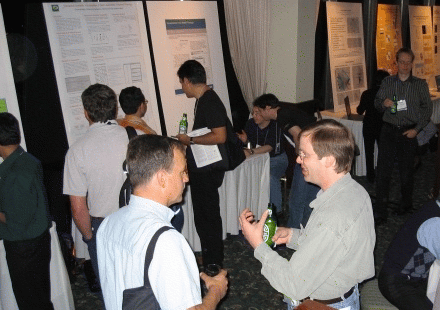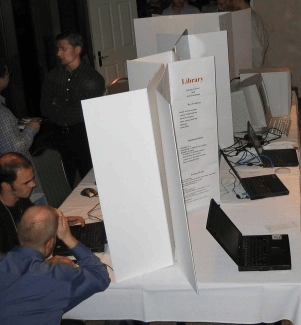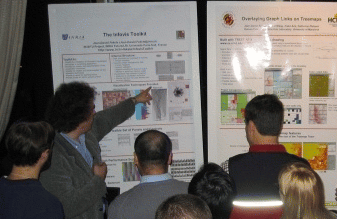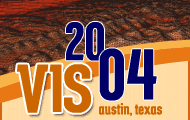Posters

The posters program offers a timely venue for significant new
visualization work. Posters have been an integral part of many
areas of scientific research, but have only recently been
revived at Visualization. Examples of appropriate visualization
work include, but are not limited to, work in progress, research
exploring new problems or areas, student projects, and any work
that might particularly benefit from discussion with others in
the field (see also the
Frequently Asked Questions below). Case
studies in all areas of science, engineering, and medicine are
welcome.
Review criteria are interest to the community, originality,
significance, and presentation quality. Submissions will be
 limited to two printed pages and an optional draft of the
poster. Submissions should include a concise description of
the idea, the results or findings, supporting imagery and
figures, and a discussion of the implications of the work to
visualization. Full literature searches are not expected,
although relevant citations should be included. Submissions
must be in final form; those accepted will be distributed to
attendees on paper and on the conference dvd-rom as submitted
-- no revisions will be possible. Any optional drafts of
posters are submitted for review purposes only and will not be
distributed. To facilitate dissemination, discussion, and
access, posters will be on display during the entire
conference. Authors will be expected to set up their posters
the first morning, take them down the final afternoon, be
available at their poster during assigned poster sessions
during the conference, and give a one-minute presentation at a
poster summary session.
limited to two printed pages and an optional draft of the
poster. Submissions should include a concise description of
the idea, the results or findings, supporting imagery and
figures, and a discussion of the implications of the work to
visualization. Full literature searches are not expected,
although relevant citations should be included. Submissions
must be in final form; those accepted will be distributed to
attendees on paper and on the conference dvd-rom as submitted
-- no revisions will be possible. Any optional drafts of
posters are submitted for review purposes only and will not be
distributed. To facilitate dissemination, discussion, and
access, posters will be on display during the entire
conference. Authors will be expected to set up their posters
the first morning, take them down the final afternoon, be
available at their poster during assigned poster sessions
during the conference, and give a one-minute presentation at a
poster summary session.
Abstracts will be accepted electronically in PDF. The draft of
the poster may be in either Powerpoint or PDF. Both should be
submitted using the Poster Submission
Page (http://www.VRVis.at/visposters/). The
final poster size should not exceed 60 inches wide x 40 inches
tall (approximately 150 cm x 100 cm).
For more information please contact David
Laidlaw at dhl@cs.brown.edu,
Victoria Interrante at interran@cs.umn.edu, or Robert
Kosara at kosara@vrvis.at.
Deadline: August 1, 2004
Frequently Asked Questions
What is the purpose of a poster?
There are different reasons for submitting your work as a
poster. Maybe the work wasn't quite mature enough at the papers
deadline, but you would like to show it to your colleagues. Or you
want some feedback on what others think about it. Maybe the work was
interesting but not of such a great value that it would warrant a
paper (student projects often fall into this category). Or you may
have some late breaking results you want to show the world before
writing a complete paper.
A poster presentation provides you with the chance to get more
feedback than a paper presentation, and you can get in contact with
people working in a similar field, or who are interested in your work.
What makes for a good poster?
The main points of the poster should be easily readable from about
three meters away. The poster may also have more dense text, suitable
 for viewers who come for a closer look, standing perhaps one meter
away. Consider also that the material on the poster should be useful
for you to illustrate key points when discussing your work
individually with attendees during your session. And don't forget to
include your name, affiliation, and contact information on the
poster. At the poster session, you should have your business card or a
leaflet ready to give to interested people.
for viewers who come for a closer look, standing perhaps one meter
away. Consider also that the material on the poster should be useful
for you to illustrate key points when discussing your work
individually with attendees during your session. And don't forget to
include your name, affiliation, and contact information on the
poster. At the poster session, you should have your business card or a
leaflet ready to give to interested people.
What, technically, is a poster?
A poster is usually printed onto a large piece of paper, which covers
most or all of the posterboard it is mounted on. Traditionally,
posters were formed from a collection of individual letter-size sheets
of paper, each containing a slide or image. With typesetting
applications, it is often possible to create a single large-format
document and print it in "tiles" on letter-size sheets that can be
mounted side by side on posterboard to form the document. If you have
access to a large-format printer, printing directly on a large piece
of paper is certainly preferable, however.
At the conference, you will mount your poster onto a posterboard for
display on the wall of the session space. Posterboards will be
supplied by the conference organizers.
If a poster has multiple authors, do we all need to stand by the poster during our session?
During the session, the poster must be staffed at all times by at
least one person. You do not all need to stand by the poster
throughout the session. In fact, you may wish to "tag team,"
taking turns manning your own poster and seeing the other
posters in the session.
Will I have a table to put my laptop or other gear on?
Yes, during your session you will have a table to stand at and put
things on.
Will I have an internet connection for my laptop?
Probably not. It's best not to plan on having an internet connection
during your session.
Will AC power be available for my laptop or other devices?
Sorry, we can t promise AC power outlets. Charge your batteries before
the session.
Can I leave my laptop or other equipment there before
or after the session?
The poster sessions are in unsecured open areas. Take your laptop and
all your gear with you.
|

